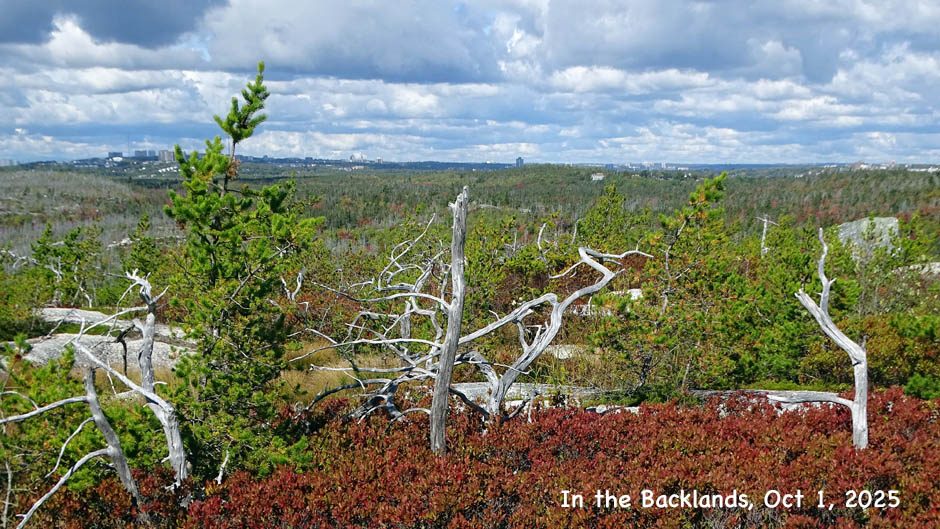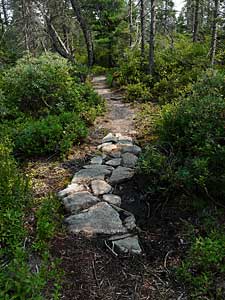The first lands formally protected to conserve ecological and cultural values were the “Capt. Arnell Lands” (12.1 ha), donated to the Nova Scotia Nature Trust (NSNT) by the Field brothers (Roger, Nigel, Kenneth, Peter, Robert, Chris, and Nicholas Field) in 2003. In 2009, an adjacent property (22.9 ha) belonging to the Napier family (Agnes, Corinne, Mary, Murray & Paul Napier and Ben MacIntosh) was contributed to NSNT. Together, these properties make up the Purcell’s Cove Conservation Lands administered by the Nova Scotia Nature Trust.
On June 24, 2014, HRM Regional Council approved a request by the Nova Scotia Nature Trust to have four HRM owned properties rezoned to (PA) Protected Area. These properties (40.5, 20.2, 18.4 and 5.6 ha) abut or are close to the Purcell’s Cove Conservation Lands.
The Backlands Coalition is seeking protection of as much as possible of the undeveloped lands within the Backlands in order to conserve important species and ecosystems maintain vital ecosystem services, preserve sites of historical significance, and to allow continued public access to the many trails and enjoyment of a wilderness experience within close proximity to urban core areas. Currently 120 ha are formally protected and 508 ha are in Crown land. See Fig 1, page 9 in Purcell’s Cove Backlands: Proposed Protected Area, cited below, for the distribution of these lands.
We were very encouraged on 2018 by a proposal by the Shaw group and the Nature Conservancy of Canada to protect the largest block (162 ha) of private land in the Backlands by Colpitt and Williams Lakes, the “Williams Lake Backlands”. Those lands have now been legally protected as the Shaw Wilderness Park, officially opened on Jan 20, 2020.
On 16 Mar, 2022, Nova Scotia Nature Trust announced a new acquisition in the Backlands – See Nova Scotia Nature Trust announces new protected Jack Pine barrens in the Backlands 16Mar202
See the documents and websites below for more information.
Purcells Cove Conservation Lands
Page on the Halifax Field Naturalists website.
Purcells Cove Backlands: Proposed Protected Area
Document prepared by Alice Morgan and Kevin Hooper (Nova Scotia Nature Trust) for the Community Design Advisory Committee, Regional Plan 5 Year Review, Halifax Regional Municipality, in October, 2012. This document describes the four HRM parcels of land, their uses and their relationship to the Purcell’s Cove Conservation lands.
Protecting the Backlands within the Halifax Green Network
This Document was prepared by the Purcell’s Cove Neighbourhood Committee for the Halifax Green Network Public Submissions Process, July 10, 2015. It provides an overview of the values of the Backlands that so many would like to see preserved for future generations of people and wildlife.
Shaw Wilderness Park
On Halifax Trails. describes hiking trails, provides trails map etc.
Halifax’s New Shaw Wilderness Park
Article by Kathleen Hall on WLCC website describes the history of the park which was officially opened on January 20, 2020.
Nature Stories: Allan Shaw
YouTube Video by NCC (Nature Conservancy of Canada), Feb 2020. “This is about providing an experience for people, forever” says Allan Shaw of the opportunity to protect rare habitat in Halifax.
Nova Scotia Nature Trust announces new protected Jack Pine barrens in the Backlands 16Mar2022
Post on this website. “We’re pleased to announce a new protected property in the Purcells Cove backlands area, sitting on 27 acres of upland forests, forested swamp and open woodlands and peatlands.”
Suite of new NS Nature Trust conservation properties include land in the Backlands 23Dec2022
Post on this website Dec 23, 2022
Analysis of Urban Wildland Boundaries in Shaw Wilderness Park – A Path Forward to Shaping Urban Planning Perspectives
by Scott D. Inman, Dalhousie University School of Planning PLAN 6000 – Major Project Final Report December 12, 2021
Golden Heather in flower in the Backlands 30Jun2023
And some thoughts about what’s involved in keeping it around.
Post by David Patriquin on backlandscoalition.ca, June 30, 2023
Nutrient fertilization by dogs in peri-urban ecosystems
Pieter De Frenne et al., 2022 in Ecological Solutions and Evidence
Why biodiversity net gain requires an ecological permission system
Emma Gardner et al., (2022). Town and Country Planning. pp. 391-402. “Biodiversity net gain (BNG) is an approach to development that aims to leave the natural environment in a measurably better state than beforehand…‘If BNG is to be truly achieved, spreadsheet metrics and the planning system approach
must be complemented by some form of ecological permission system to sit alongside the planning system and existing provisions for protected species in the same way as other parallel systems’

